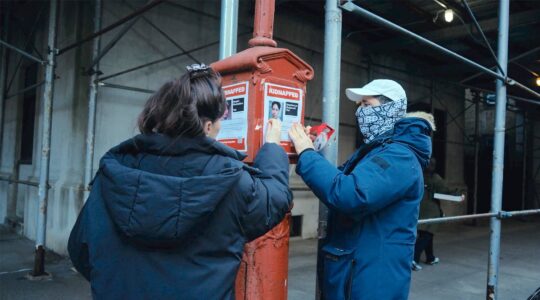REPORTER’S NOTEBOOK
WASHINGTON (JTA) — The standout display in “State of Deception,” the special exhibition on propaganda at the U.S. Holocaust Memorial Museum, doesn’t really stand out.
It’s a little booklet buried in a stunning array of posters, multimedia and interactive exhibits: “Der Anti-Nazi,” published in 1932 by a German Jewish umbrella group.
Its arguments, according to Steven Luckert, the museum’s curator, are unassailable. Its logic is irrefutable. And its impact was zero.
The booklet could barely hold its own against a massive Nazi propaganda machine that aimed for the gut instead of the head.
Not far from the display case with the booklet and other small publications refuting Nazi claims is a poster of Adolf Hitler from the same year, running for chancellor. His huge disembodied face — optimized, softened so that he seems firm, yet empathetic — is silhouetted against a black background.
“They held it back” until late in the election,” Luckert said, “so that it would stand out against brightly colored posters.”
It worked: Hitler was catapulted into contention for the chancellorship, with 32.3 percent of the vote, up from just 2.6 percent four years earlier; he seized the post after political maneuverings in early 1933.
Examinations of Nazi propaganda traditionally focus on how its purveyors operated just prior to and during World War II, selling its plans for European conquest and its dehumanization of Jews and Gypsies.
“State of Deception” instead makes its focus the effort from the early 1920s through 1932 and beyond to make Nazism not just palatable but inevitable for Germans.
The exhibit, and an accompanying interactive Web site, are thematic: How Hitler was sold as a leader; how Jews were at first subtly excluded from notions of Germanness in pitches to some sectors of German society that held Jews in affection; how youths were empowered through Nazism; how an atomized, despairing nation longing for a notion of unity was exploited.
Some of these will seem alien to the modern American museum-goer. In a culture that lionizes youthful rebellion, for instance, no one is imagining a national youth corps.
Other refractions are unsettling: The casting of Hitler as a savior, the longing for community. “Volksgemeinschaft,” or national community, transcended “class, religion and region,” according to the museum literature. The notion of a nationalized community of hope coupled with Hitler’s best-selling biography of struggle and a welter of adoring, hyper-idealized portraits will inevitably draw comparisons with last year’s successful Barack Obama presidential campaign.
Similarly, using selective information to gin up fears of foreign attack and justify preemptive war also has recent echoes in the push for the Iraq War.
Such comparisons are, of course, facile: the Bush and Obama campaigns were bereft both of the racism and violence that fueled the Nazi rise; hatred was the killer, and propaganda was its abettor.
Still, the organizers say, the questions pertain, particularly for the school groups from around the country for whom the museum is a must-see.
Among these is how one effectively counters propaganda once the facts have failed. Another is whether political ad copywriters should consider the medium as well as the message.
“One of the discussions that we’ve had with a lot of groups is, ‘Are the techniques themselves problematic or are they only problematic when you look at the agenda?” said Sarah Ogilvie, the director of the museum’s National Institute for Holocaust Education. “That’s not a settled question – we’ve seen people debate the question whether the techniques in of themselves are problematic and whether it’s only the agenda. That gets people to think about their work, the consequences of their work.”
JTA has documented Jewish history in real-time for over a century. Keep our journalism strong by joining us in supporting independent, award-winning reporting.





